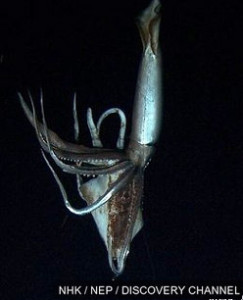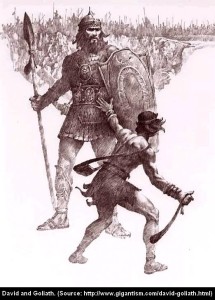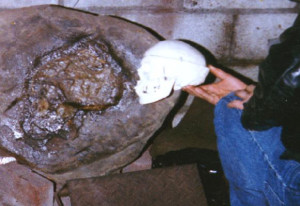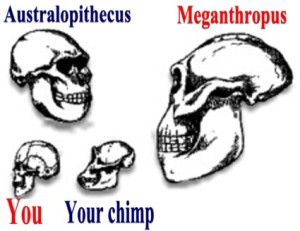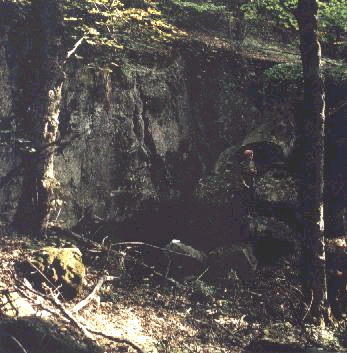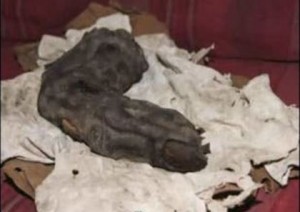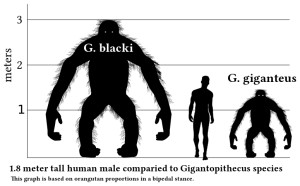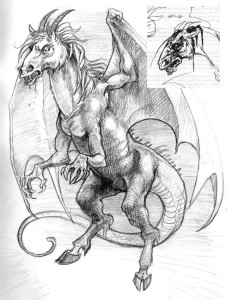Now is time for the last post of the series called “Creatures From Beyond”, but don’t worry World is full of creatures and I will return to this topic when I have enough footage. But for now this is the last post and it belongs to creature called The Kraken:
Kraken (pron.:/ˈkreɪkən/ or /ˈkrɑːkən/ or /ˈkrækən/)[1] are legendary sea monsters of giant proportions said to dwell off the coasts of Norway and Greenland.
The legend may have originated from sightings of giant squid that are estimated to grow to 13–15 m (40–50 ft) in length, including the tentacles.These creatures normally live at great depths, but have been sighted at the surface and have reportedly attacked ships.
The sheer size and fearsome appearance attributed to the kraken have made it a common ocean-dwelling monster in various fictional works.
History
The 13th century Old IcelandicsagaÖrvar-Odds saga tells of two massive sea-monsters called Hafgufa (“sea mist”) and Lyngbakr (“heather-back”). The hafgufa is believed to be a reference to the kraken:
Now I will tell you that there are two sea-monsters. One is called the hafgufa (sea-mist), another lyngbakr (heather-back). Whales are the biggest of everything in the world, but the hafgufa is the greatest monster occurring in the water. It is its nature that it swallows both men and ships and whales and everything that it can reach. It is submerged both by day and night together, and when it strikes up its head and nose above the surface, then it stays at least until the turn of the tide. Now, that sound we sailed through? We sailed between its jaws, and its nose and lower jaw were those rocks that appeared to you in the ocean, while the lyngbakr was the island we saw sinking down. However, Ǫgmundur Floki has sent these creatures to you by means of his secret arts for to cause the death of you and all your men. He thought that more men should have gone the same way as those that had already drowned, and he expected that the hafgufa would have swallowed us all. Today I sailed through its mouth because I knew that it had recently surfaced.[5]
After returning from Greenland, the anonymous author of the Old Norwegian scientific work Konungs skuggsjá (circa 1250) described in detail the physical characteristics and feeding behavior of these beasts. The narrator proposed there must only be two in existence, stemming from the observation that the beasts have always been sighted in the same parts of the Greenland Sea, and that each seemed incapable of reproduction, as there was no increase in their numbers.
There is a fish that is still unmentioned, which it is scarcely advisable to speak about on account of its size, because it will seem to most people incredible. There are only a very few who can speak upon it clearly, because it is seldom near land nor appears where it may be seen by fishermen, and I suppose there are not many of this sort of fish in the sea. Most often in our tongue we call it hafgufa. Nor can I conclusively speak about its length in ells, because the times he has shown before men, he has appeared more like land than like a fish. Neither have I heard that one had been caught or found dead; and it seems to me as though there must be no more than two in the oceans, and I deem that each is unable to reproduce itself, for I believe that they are always the same ones. Then too, neither would it do for other fish if the hafgufa were of such a number as other whales, on account of their vastness, and how much subsistence that they need. It is said to be the nature of these fish that when one shall desire to eat, then it stretches up its neck with a great belching, and following this belching comes forth much food, so that all kinds of fish that are near to hand will come to present location, then will gather together, both small and large, believing they shall obtain there food and good eating; but this great fish lets its mouth stand open the while, and the gap is no less wide than that of a great sound or fjord, And nor may the fish avoid running together there in their great numbers. But as soon as its stomach and mouth is full, then it locks together its jaws and has the fish all caught and enclosed, that before greedily came there looking for food.[6]
Carolus Linnaeus classified the kraken as a cephalopod, designating the scientific name Microcosmus marinus in the first edition of his Systema Naturae (1735), a taxonomic classification of living organisms. The creature was excluded from later editions.Linnaeus’s later work, Fauna Suecica (1746) calls the creature singulare monstrum, “a unique monster”, and says of it Habitare fertur in mari Norwegico, ipse non dum animal vidi, “It is said to inhabit the seas of Norway, but I have not seen this animal”.
Kraken were also extensively described by Erik Pontoppidan, bishop of Bergen, in his Det Forste Forsorg paa Norges Naturlige Historie “Natural History of Norway” (Copenhagen, 1752–3).Pontoppidan made several claims regarding kraken, including the notion that the creature was sometimes mistaken for an islandand that the real danger to sailors was not the creature itself but rather the whirlpool left in its wake.However, Pontoppidan also described the destructive potential of the giant beast: “it is said that if [the creature’s arms] were to lay hold of the largest man-of-war, they would pull it down to the bottom”.According to Pontoppidan, Norwegian fishermen often took the risk of trying to fish over kraken, since the catch was so plentiful(hence the saying “You must have fished on Kraken”). Pontoppidan also proposed that a specimen of the monster, “perhaps a young and careless one”, was washed ashore and died at Alstahaug in 1680.By 1755, Pontoppidan’s description of the kraken had been translated into English.
Swedish author Jacob Wallenberg described the kraken in the 1781 work Min son på galejan (“My son on the galley”):
… Kraken, also called the Crab-fish, which is not that huge, for heads and tails counted, he is no larger than our Öland is wide [i.e., less than 16 km] … He stays at the sea floor, constantly surrounded by innumerable small fishes, who serve as his food and are fed by him in return: for his meal, (if I remember correctly what E. Pontoppidan writes,) lasts no longer than three months, and another three are then needed to digest it. His excrements nurture in the following an army of lesser fish, and for this reason, fishermen plumb after his resting place … Gradually, Kraken ascends to the surface, and when he is at ten to twelve fathoms, the boats had better move out of his vicinity, as he will shortly thereafter burst up, like a floating island, spurting water from his dreadful nostrils and making ring waves around him, which can reach many miles. Could one doubt that this is the Leviathan of Job?
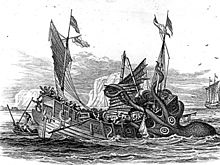
Pierre Dénys de Montfort‘s “Poulpe Colossal” attacks a merchant ship (1810)
In 1802, the French malacologistPierre Dénys de Montfort recognized the existence of two kinds of giant octopus in Histoire Naturelle Générale et Particulière des Mollusques, an encyclopedic description of mollusks. Montfort claimed that the first type, the kraken octopus, had been described by Norwegian sailors and American whalers, as well as ancient writers such as Pliny the Elder. The much larger second type, the colossal octopus, was reported to have attacked a sailing vessel from Saint-Malo, off the coast of Angola.
Montfort later dared more sensational claims. He proposed that ten British warships, including the captured French ship of the lineVille de Paris, which had mysteriously disappeared one night in 1782, must have been attacked and sunk by giant octopuses. The British, however, knew—courtesy of a survivor from the Ville de Paris—that the ships had been lost in a hurricane off the coast of Newfoundland in September 1782, resulting in a disgraceful revelation for Montfort.
Appearance and origins
Since the late 18th century, kraken have been depicted in a number of ways, primarily as large octopus-like creatures, and it has often been alleged that Pontoppidan’s kraken might have been based on sailors’ observations of the giant squid. In the earliest descriptions, however, the creatures were more crab-likethan octopus-like, and generally possessed traits that are associated with large whales rather than with giant squid. Some traits of kraken resemble undersea volcanic activity occurring in the Iceland region, including bubbles of water; sudden, dangerous currents; and appearance of new islets.
Etymology
The English word kraken is taken from Norwegian but its origins are otherwise obscure.In Norwegian, Kraken is the definite form of krake, a word designating an unhealthy animal or something twisted (cognate with the English crook and crank).In modern German, Krake (plural and declined singular: Kraken) means octopus, but can also refer to the legendary Kraken.
Legacy
Although fictional and the subject of myth, the legend of the kraken continues to the present day, with numerous references existing in popular culture, including film, literature, television, video games and other miscellaneous examples (e.g. postage stamps, a rollercoaster ride, and a rum product).
In 1830 Alfred Tennyson published the irregular sonnetThe Kraken,which described a massive creature that dwelled at the bottom of the sea:
Below the thunders of the upper deep;
Far far beneath in the abysmal sea,
His ancient, dreamless, uninvaded sleep
The Kraken sleepeth: faintest sunlights flee
About his shadowy sides; above him swell
Huge sponges of millennial growth and height;
And far away into the sickly light,
From many a wondrous grot and secret cell
Unnumber’d and enormous polypi
Winnow with giant arms the slumbering green.
There hath he lain for ages, and will lie
Battening upon huge seaworms in his sleep,
Until the latter fire shall heat the deep;
Then once by man and angels to be seen,
In roaring he shall rise and on the surface die.Pontoppidan’s description influenced Jules Verne‘s depiction of the famous giant squid in Twenty Thousand Leagues Under the Sea from 1870.
And now for the first time they have filmed this giant beast in the depths of the ocean:
After decades of searching for the giant squid, scientists have finally found and filmed the legendary creature in its native habitat. Their journey and discovery will be featured Sunday, January 27, at 8/7c in Monster Squid: The Giant Is Real, the two-hour season finale of the Curiosity series.
We recently sat down with Leslie Schwerin, director/producer of Monster Squid: The Giant Is Real for Discovery Channel, to talk about the expedition, the incredible discovery and all things giant squid. Here are the top 10 things we learned about Architeuthis.
#10. We still know very little about the giant squid, including how it hunts.
“There’s a difference of opinion about how they catch their prey,” Leslie Schwerin told us. “Dr. Tsunemi Kubodera, as I understand it, believes that giant squid catch their prey with their tentacles. So they’re going along and they see something yummy, and their tentacles go out and grab it and bring it in. Dr. Steve O’Shea believes the giant squid’s going along and its tentacles are hanging down at 45 degrees. It’ll catch its prey, and then the body will go to it instead of bringing it in.”
VIDEO: The Giant Squid Discoverers
#9. Humans have been aware of the giant squid for centuries.
Although no one has ever seen a giant squid alive in its natural habitat until now, humans have been clued into its existence for centuries, perhaps even longer. Giant squid carcasses will occasionally wash ashore, and there have been sightings of giant squid at the ocean’s surface. The ancient Greeks may have first described the creature in the fourth century B.C. In the first century B.C., Pliny the Elder wrote of an enormous squid in his Natural History. The animal he described had 30-foot-long arms, weighed 700 pounds and had a head “as big as a cask.”
#8. There’s an even larger squid than the giant squid.
The colossal squid, which still has not been seen alive in its natural habitat, is thought to be even larger than the giant squid (although its tentacles are shorter). The largest known colossal squid was hauled to the surface by fishermen off New Zealand in 2007. It weighed around 1,000 pounds.
#7. The giant squid has a sharp beak.
“Giant squid have a big old beak that is supposedly really sharp,” said Leslie Schwerin. Shaped like a parrot’s beak, the giant squid’s beak is incredibly hard and resistant to fractures and bending. It likely uses its beak to dismember and perhaps paraylze its prey, although no one has ever seen a giant squid feeding.
BLOG: Are We in the Midst of a Squid Invasion?
#6. Giant squid battle sperm whales.
“It’s pretty clear that sperm whales eat giant squid, and giant squid don’t go down without a fight,” said Leslie Schwerin. “Scientists, and just anyone walking on the beach seeing a beached sperm whale, will often see these sucker marks and bite marks from a giant squid. If they open up the stomach of a sperm whale, they’ll often see remains of a giant squid – especially the beaks, because the beaks don’t get broken down. Scientists speculate that the battles giant squid and sperm whales engage in are pretty vicious.”
#5. Giant squid regenerate their tentacles.
“The giant squid that we found didn’t have its tentacles,” said Leslie Schwerin. “We don’t know why exactly. It could be that it lost them in a fight with a sperm whale, or they could’ve been hooked on a fisherman’s line, and that severed their tentacles. But the tentacles regenerate.”
Not all squid regenerate their tentacles, but certain deep sea squid like Architeuthis can sacrifice them as a defense mechanism, allowing them to quickly escape to safety.
#4. The giant squid is as long as a whale.
“What’s fascinating about the giant squid is its size,” Leslie Schwerin told us. “It’s just really big. They can get up to maybe 50 or 60 feet long,” which rivals the length of most large whales (other than fin and blue whales). Tentacles make up the lion’s share of their length. Tentacles aside, the giant squid’s body is the length of a large, adult great white shark.
NEWS: Giant Squid: Still a Deep Mystery
#3. The giant squid’s eye is as big as your head.
“Its eyes are supposedly the largest in the animal kingdom,” said Leslie Schwerin. “As big as a basketball perhaps. I mean bigger than my head, which is amazing to think about. And that’s so they can see in the dark. We can’t see down 2,000 feet — it’s all dark to us — but they see things. They see light trickling through, and that’s because their eyes are so big.”
#2. As gigantic as they are, giant squid are really hard to find.
“It’s really hard to find a giant squid in its natural habitat,” said Leslie Schwerin. “They’re really deep. 2,000 to 3,000 feet down. That’s not a hospitable environment for us, so we have to go down in submersibles, which are loud and have lights and scare them away.
“I imagine that it’s probably really hard to find a giant squid because we don’t know how to behave or survive in their environment, so we need all this equipment that’s loud, bright and it all scares them away. I think they’re shy creatures. They’re solitary creatures, so they don’t swim in schools. Even though there may be millions of them, they’re spread out throughout the seas, and it is like a needle in a haystack.”
#1. The giant squid is actually a gentle giant.
“It’s huge. It’s weird-looking. We know that,” said Leslie Schwerin. “And I think people are fascinated with ‘monsters.’ It does fit the description, in a way, of a monster even if it’s a gentle monster. But our imaginations take off and we think it’s this crazy monster of the sea that’ll take down ships and sailors. There were certainly stories about it doing that in the past. It really does excite people, and people love their monsters — especially ones they haven’t seen.”
And here is the video footage:
Then I just have to post a video from progressive Metal group called Mastodon, because they have an album called Leviathan and this is a song called “Seabeast”:
I hope you enjoyed the series and keep on searching. So now it is time to move on to another topics, but in the future there will be more… CREATURES FROM BEYOND!


